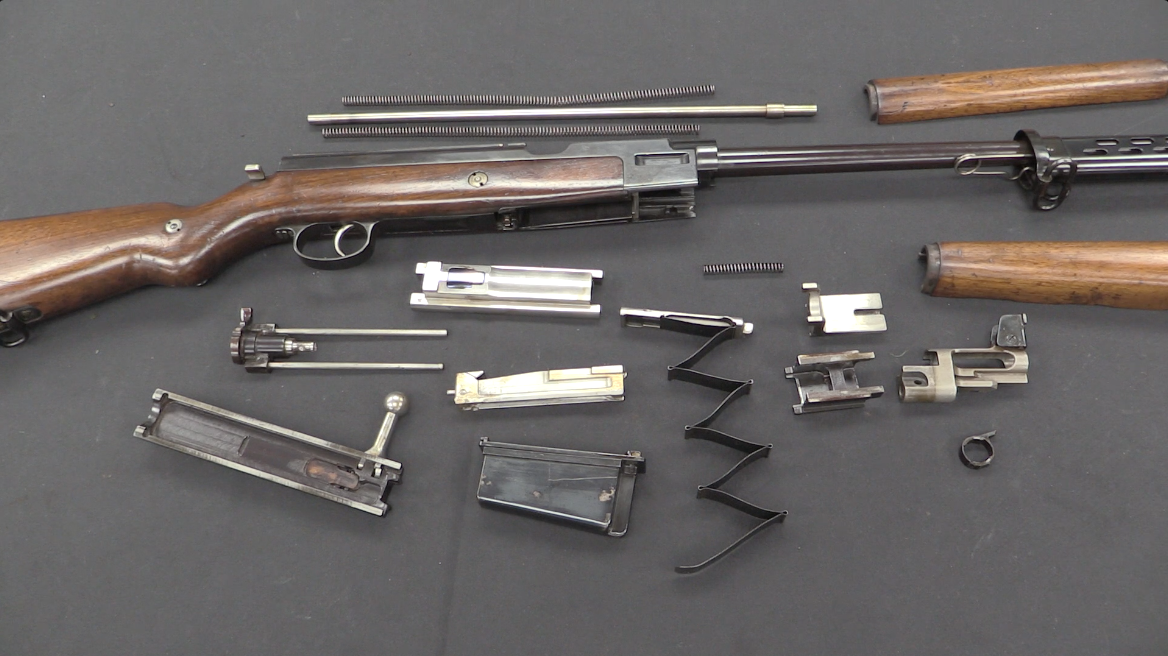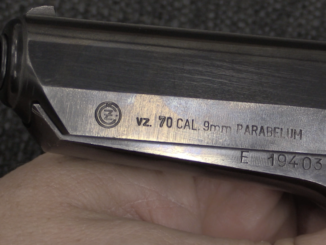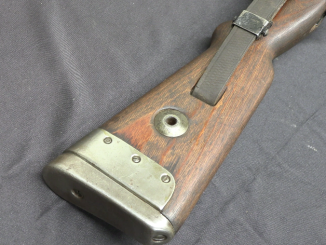In 1952, Czechoslovakia adopted a whole new family of small arms, including the vz.52 pistol, vz.52 rifle, and vz.52 light machine gun. The rifle and LMG were both chambered in the Czech 7.62x45mm cartridge, and both would be adapted to the Soviet standard 7.62x39mm a few years later, in 1957. Very shortly thereafter, the Czechs would also introduce a heavier universal machine gun version in 7.62x54mmR under the designation UK vz.59 (universal machine gun model 59).
The UK 59 was basically a scaled up sibling of the vz.52 and vz.52/57 machine guns, although it fed from a belt only, where its smaller predecessors had allowed either belt or magazine feed. It used a pivoting locking block system much like the Walther P38 and Beretta pistols, in conjunction with a long stroke gas piston much like that of the vz.26 light machine gun.
The weapon did not see much interest outside of Czechoslovakia, although it does remain in service in that region in the modernized 7.62x51mm iteration.
Thanks to Marstar for letting me examine and shoot their UK vz.59!




“The weapon did not see much interest outside of Czechoslovakia, although it does remain in service in that region in the modernized 7.62x51mm iteration.”
Modern Firearms query – https://modernfirearms.net/en/machineguns/czech-republic-machineguns/vz-59-uk-vz-59-eng/ – say something different, about external interest:
At the present time, UK 59 is a standard universal MG of the Czech and Slovak armies, and it also was widely sold for export.
But without giving information to whom it is sold.
Perhaps the customers wore trench coats and fedoras. I don’t recall any Soviet requirement for the Czechs or the Slovaks to publicly disclose arms deals outside the Warsaw Pact…
I am not aware of single country who would purchase vz.59N, although there were some attempts to sell them in Africa. Pretty well all socialist and other nations with ‘progressive’ type governments (such as Libya or Algeria) would purchase Soviet small arms.
Angola is a possibility
They were using Vz58 rifles.
The MPLA regime were also very sore about the Soviets disappearing from the defence of the capital, Luanda during one of the big South African incursions (Cubans stayed and fought).
Passive aggressive “favours” towards the Soviets were therefore likely to occur.
Unlike most of the client regimes, the Angolan MPLA regime also had its own international currencies to pay with, due to having revenues from offshore oil, and lots and lots of diamonds.
What is the name of the company who manufactured the UK59 in Europe???? I would like to buy barrels. Appreciate the help.
John White 714-654-5877
“fed from a belt only”
Which is of peculiar construction to allow direct push, despite rim of cartridges.
Similar belt were developed in Soviet Union: http://копанина.рф/publ/17-1-0-734
see:
5th photo from top: belt non-disintegrating for experimental Berezin machine gun, 1930s
6th photo from top: belt non-disintegrating for experimental СП-74
7th photo from top: belt non-disintegrating for Nikitin 1960 machine gun [this weapon is also known as Nikitin-Sokolov machine gun, see photos:
http://www.dogswar.ru/oryjeinaia-ekzotika/strelkovoe-oryjie/6339-opytnyi-pylemet-sist.html
it was most serious competitor to Kalashnikov machine gun, which would won competition and become PK (1961), later Nikitin and Sokolov will created 12,7-mm machine gun NSV which will be adapted and become known as Utyos]
Additional photos of belt for Nikitin machine gun:
https://mpopenker.livejournal.com/1084267.html
chapter часть 5, чехо-советско-китайская
loaded into machine gun – belt itself
belt for Czechoslovak machine gun
similar solution (open non-disintegrating belt) was also used in PRC Type 67 machine gun
“weapon did not see much interest outside of Czechoslovakia”
Interestingly, there exist U.S. made (922(r) compliant from legal point-of-view) self-loading version of that weapon: http://www.semiuk59.com/semi-uk.html
This site claims [vz. 59] is the rarest GPMG ever adopted into the Soviet Bloc, but it seems to be FALSE, taking in account existence of 7.62mm KGK Géppuska
http://www.hungariae.com/Goryunov.htm
I am impressed and to some degree surprised (due to Canadian gun law) that Marstar has in their stock this (today already) vintage machinegun. Whatever was left from Czech military (1/6th of original size) may have kept some of them, but large number were understandably disposed of thru foreign sales, such as the one we see here. As I understand they try to ‘modernize’ with purchase of FH Minimi in 7.62Nato. Not really smart solution, but that’s probably political issue more than anything else.
As already mentioned before, I was intimately involved with this piece during my compulsory service. I did not hear of any shortcomings and soldiers generally liked it; in light version it was not difficult to handle/ carry. Some applied solutions were quite advanced (such as barrel lock and action charging). Sometimes problems occurred when firing blanks. This is probably due to close location of gas port to chamber as gas pressure generated in barrel was not sufficient to drive the action especially in cold weather (replaceable muzzle orifice was used for training purposes).
“(today already) vintage machinegun”
This reminded me about one image, it is response to following events:
[29 January 2018] АК-12 was adopted by Russian Ministry of Defense
[29 January 2018] АК-15 was adopted by Russian Ministry of Defense
https://mpopenker.livejournal.com/2285739.html
Your weapon system is more than 60 years old? It is OUTDATED!!!111
That is true statement – any one of those designs are basically ‘obsolescent’. They remain in service because there is nothing better/ more advanced at the moment. I see drive toward more accurate rifles in U.S. service but their practicality in physically demanding use is in question.
Current U.S. forces program for new ammunition-weapon system is New Generation Squad Weapons
https://taskandpurpose.com/army-next-generation-squad-weapon/
it is said it will be in 6.5…6.8 mm caliber, which is small for
new assault rifle will unleash a hailstorm of specially-designed shells
which mean it will fire HE-filled projectiles, so I quite confused why they choose so tiny caliber for that caliber.
It is supposed to replace M249, starting in 2022 (FiscalYearTimeline), they want pressure between 60 and 80, when current system use 45.
That is hugely over-rated. Pie in the sky – but I may be wrong. Another even bigger issue – this will present ever increasing logistics demand. Another ‘new’ round with questionable gain; who needs it?
“who needs it?”
That one which is out-ranged, when using 5,56×45 mm NATO squad machine gun.
“Sometimes problems occurred when firing blanks.”
It should be noted, that other machine guns also might have somewhat lowered reliability when firing blanks. I don’t know about Czechoslovak ammunition, but Soviet made 7,62x54R blanks were shorter than live cartridges, see 1st photo from top, 1st cartridge from right here: http://gunrf.ru/rg_patron_7_62x54_ru.html
They are good looking shots. Designers of original 7.62x54R had lucky hand. The bullet-less ‘rosette’ type shot I see there looks very much like we had.
One item to re-iterate: look where is gas tap – it is very close to chamber. Therefore the pulse comes too early and peters out quickly. With ball ammo it does not matter that much, with blanks it does.
One detail I want to point out is chrome finish on action components. This is quite rare among small arms. Good thing about it was that they did not corrode, were easy to keep clean and were easy to see in darkness during emergency tear-down.
I haven’t seen the video yet, so I don’t know whether Ian comments on the purpose of the Chrome.
According to Popelinsky, hard chrome plating on the locking surfaces of the VZ58 rifle contribute to low friction and Wear resistance,
allowing the action to be timed to unlock with significant chamber pressure.
Chrome definitely makes the parts easier to clean and maintain, and that probably contributes to the user’s liking for the gun.
Chromed chambers and Bores are a blessing as well.
Another item I like to bring attention to is the 3-dimensional cam on RH side of operating rod which comes to contact with advancing arm roller. It allows for square contact at any point of its travel thus improving life span and reliability and it is right way to do it.
Interestingly, on PKM, where the belt advance is almost identical, there is simplified 2-dimensional one (look at Negev for comparison). My question would be: how was this achieved before CNC machining was in common use? My guess would be by copying from master/ template by hydraulic drive; something like propellers were made. Hardly anyone can answer this question because there are likely no survivors who worked on it.
I’m a machinist, and while I’m not old enough to have done this sort of thing, I have an interest in the history of my craft; what follows is based on reading old textbooks, and talking to old machinists, rather than direct experience. Still, I’m pretty confident I have the general idea right.
Copy milling is mainly for complex or arbitrary surfaces that can’t be directly generated; since the contour on the operating rod is easily generated with a milling cutter of the same radius of the roller, it would be overkill.
In small quantity, one would make that profile on a universal mill with a dividing head. The dividing head is linked to the feed motion through gears, and rotates the blank as the milling cutter travels along the length. You’d fixture the op rod off-center, so the rotation is about the pivot point of the belt-advance arm.
For mass production, one would prefer to use a simpler milling machine, so you’d forgo the geared dividing head. As before, you’d fixture it to rotate about the pivot axis of the advancing arm, but the fixture’s rotation would be governed by a cam and follower. The cam would be made on a universal mill, as above, but the resulting fixture could go on a cheap production mill.
I remember playing around with a captured Vz 52/57 Machine gun in Iraq. Perhaps some UK 59’s made it there too…
I do not think so, at least did not see any proof of it. All I saw in Iraqi hands was PKMs.
Without photo of reel we can’t said anything for sure. However, considering following facts
1) during Soviet intervention in Afghanistan samples of PKT adapted for stand-alone machine gun were observed
2) some Czechoslovak armoured vehicles were exported to various Arab states
it is possible that in fact tank variant of vz. 59 machine gun, salvaged from vehicle damaged beyond repair, was used in stand-alone machine gun.
For me OT-62:
https://en.wikipedia.org/wiki/OT-62_TOPAS
seems most probable “donor”, looking on operators (notice that Iraq – All destroyed or scrapped), however:
-operators section do not give source of vehicles (Polish-made were armed with PKT machine gun)
-in most cases is does not give what variant of that vehicle was delivered (OT-62A was gun-less).
-it is possible that OT-62 made for export have altered armament to fit customer needs
The Vzor 52 LMG using the grip as the charging handle and loading with either top-mounted box magazines or belts, and using a dual-trigger set up a bit like the MG34 was sold to Cuba in the early 1960s and used along with the 7.92x57mm ZB-37 by the Cuban revolutionary state army and militia.
News just out that youtube will start sanctioning gun videos 🙁
That won’t stop mass shootings. It will only make people STUPID ENOUGH TO BELIEVE THAT THE GOVERNMENT CAN SOLVE EVERYTHING! It’s basically the political censorship committee equating SUPER HERO COMIC BOOKS to juvenile delinquency!
Guys could we please refrain from political statements here? I am here for the guns and the history related to them – not politics
@Cherndog
I hoped that I wouldn’t to do that, but I must inform you become similar to what you fight against: using emotions rather than rationale (if not why you use upper-case letters for sentences?) and just trying to make your opponent looks dumb.
Therefore I exhort you to discuss thesis rather than using Argumentum ad personam (entities?)
Is vimeo still going?
Not a very reliable MG from my experience, still used in Slovak Army.